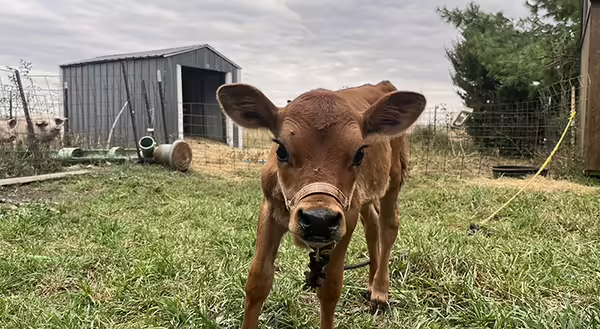
In the heart of Livingston County, Hoffman’s Little Acres stands as proof that a small farm can have a big impact. From treating a sick Jersey cow to bottle-feeding her newborn calf, Anna Hoffman’s social media posts caught my attention with their raw look at the dedication it takes to run a farm. On a crisp September evening, I visited their Fairbury farm to learn how Anna and her husband Scott have turned less than five acres into a thriving community hub for fresh food and resilience.
Anna and her husband, Scott Hoffman, own and operate Hoffman’s Little Acres in Fairbury, IL. Over the years, they have raised chickens, hogs, ducks, goats, and cattle for meat, eggs, goat milk soap, and more. Their current offerings include freezer meat sold by the piece, farm fresh eggs, goat milk soap, and raw milk.
Scott and Anna were finishing their farm chores for the evening when I arrived, so I walked with them as we got to know each other. We visited their hog pen, goat paddock, cow paddock, and chicken coop - several barn cats weaving between my legs the whole time. I even got to meet one of their milk cows, Brownie, and her newborn calf. It was invigorating to witness such a vibrant display of life in one place.
Once inside, we dove into my prepared questions at their kitchen table. As always, I’m keenly interested to learn how my farmer hosts got into their very specialized, demanding, and intimate life path.
Mutual passion for livestock husbandry
I asked, “Can you tell me a little bit about where you both grew up, and if farming was a part of the picture from early on?”
Anna started first. “I grew up 8 miles from our current farm home, here in Fairbury. Dad butchered the occasional steer himself, and we had rabbits and chickens, too. When I was a teen, I bought a horse and some sheep as pets, which meant haying and feeding daily.”
“I grew up in the Romeoville/Joliet area, in town,” Scott added. “Farming never really crossed my mind until high school. One of my best friends worked at a Naperville area dairy nearby - back when there were still farms in the area - called Clowbaltz Dairy, when I was about 17. He asked if I could help him at Clowbaltz, and I got a part-time job there eventually. I liked the personalities of the dairy cows! It was hard work, but it was fun, too.”
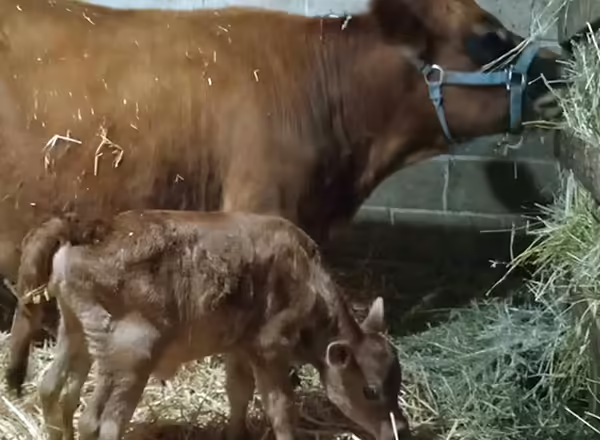
“It wasn’t until I was an adult that I worked at the vet clinic in Fairbury – East Side Vet Clinic, now called Fairbury Veterinary Hospital – that I started to really understand that working with animals could be my focus in life,” said Anna.
Anna continued, “I started milking cows at Slagel Dairy in Fairbury part-time while I worked for the vet clinic.” It was in this way that simultaneously she built her skillset. Between veterinary science and dairy, she learned how to pull calves, treat milk fever, and in her words, “you name it, if it’s happened to a cow, I’ve seen it and worked with it.”
I asked Scott what he was doing while Anna was gaining experience in dairying and veterinary care. “I worked at Clowbaltz for a few years, but then I went to work for my uncle in Downers Grove, delivering pianos. Then I worked in waste management for a few years. I didn’t really know what I wanted to do.”
I shared with Scott that I had a similar journey. During my undergraduate years, I studied Spanish and Political Science as a double major. A year before graduation, I realized I did not want to work in either field. I did some soul-searching, did a complete 180-degree turn, and applied to graduate school in a completely different program focus. I was accepted in the Crop Sciences Master of Science program at University of Illinois Urbana-Champaign before working as a vegetable farming apprentice and now as an Illinois Extension Educator. “So, you know what I’m talking about!” he commented.
He added, “I had shared with my grandmother that I believed I should get into farming, but Grandma didn’t think I could make a living with farm work. She had been there, done that, and warned me against it. But I was pretty sure of the idea after working for Clowbaltz dairy.
“So, how did you two meet?” I asked. Scott started. “So, remember, Clowbaltz was in the Naperville, Joliet, Romeoville area – and they were suffering pretty bad urban creep. The area had been rural, but was changing quickly. People started selling their land to developers and they got surrounded. They saw the writing on the wall and decided to move on as well. But they didn’t want to stop dairying, so they bought a farm in Gridley, Illinois”.
Anna continued, ”the farm that I worked for at the time sold their dairy cows to Clowbaltz. I was the herd health manager for those cows, and I went with the herd as a package deal, you might say, managing about 200 cows.”
“At this point,” said Scott, “I was working another job, this time for Coachmen campers in Indiana. The same high-school friend that I helped at Clowbaltz Dairy introduced me to Anna when I was back in the area for a weekend.”
Anna shared that they both possessed a mutual love of livestock, getting their hands dirty, and hard work. Scott moved to Chenoa, Illinois and got a job with a cement company. Meanwhile, Anna got acclimated to her new dairy job in Fairbury. They got to know each other and found that they had a lot in common.
7 months later, they were married! After a few years of working and living near Scott’s family in Indiana, they purchased their current farmstead and relocated to Fairbury, Illinois.
As someone with my own dreams of one day owning a farmstead and a few acres, I asked a few questions at once. “What kind of property were you looking for, how did you find it, and how big is it?”
“In 2002, we knew we wanted to buy our own place, so we got pre-approved for a loan. We heard through the Fairbury grapevine that this property was for sale and drove by it. We happened to be driving separately – I was in front; Scott was following me in his truck. As we pulled up, I stuck my hand out the window and gave him a thumbs-up. I immediately fell in love with the barn. I have a thing for old barns,” said Anna.
Scott told me that when he saw Anna’s thumbs-up, he had a feeling that, “this was the one.”
Anna continued, “the property is just under 3 acres which I wasn’t sure would be enough.” “But since day one,” Scott added, “the neighbors let us use their pasture next door!” That allows them access to about 5 acres, altogether.
I followed up: “Were you eventually planning to start your current farm business here, or was this just meant to be the first stop on a longer journey?”
“I don’t think we had a plan at all. We just moved here because it had a barn and acreage for the horses we had at the time. We just thought about this property as our starter farmstead/home,” Scott shared. They continued working their full-time jobs for about a decade and during this time, had their four children – Abigail, Brianna, Kayla, and Johnathon.
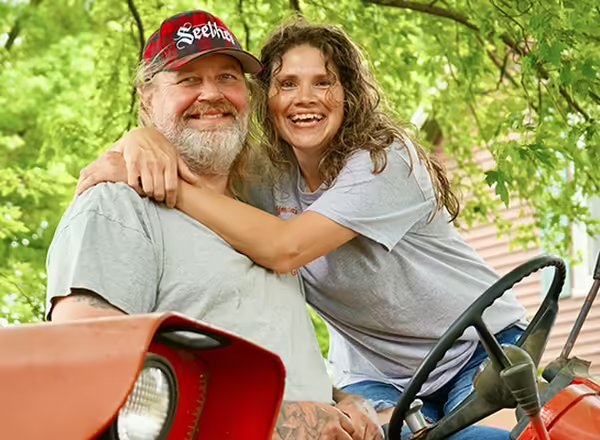
In 2013, their thinking began to change. Anna explained, “We were randomly looking for homes for sale in 2013, with acreage. We thought we needed more land to start a farm. We found a farm for sale by the owner in Chatsworth (12 miles east of Fairbury). We visited the farm, talked with the owner and took a tour. It felt like a great fit for what we wanted, which was more space for a small farm business. We could afford the place, too! We thought it was a done deal.”
But before Anna and Scott could put in an offer, an investor put a cash offer on the property and bought it out from under them.
They returned home, regrouped, and after a couple of weeks, they had a mental breakthrough. Scott and Anna realized that they didn’t need a bigger property to start a small, diversified farm business of their own. They understood that going fully organic wouldn’t be feasible due to the risk of pesticide overspray from nearby corn and soybean fields. However, they could still grow crops and raise livestock following organic practices as much as possible. They believed they could make their “little acres” work for them. “We thought it was worth a try!” said Scott.
Jumping in headfirst
They dove in headfirst, and in late 2014 started up farming operations. “We bought our first milk cow!” exclaimed Anna. “Her name was Ginger, and she was a mini-Hereford/Dexter cross. The milk didn’t taste great, and she was a little bit of a jerk – this is coming from someone who has seen it all in terms of cow personalities!” But it was their own milk from their own cow on their own land, which was an important milestone.
By the end of 2015, they had purchased feeder pigs, honey bees, goats, two beef cattle, ducks, and several Jersey milk cows. Near the end of the 2015 season, they were able to offer their first freezer meat which was bulk pork and chicken.
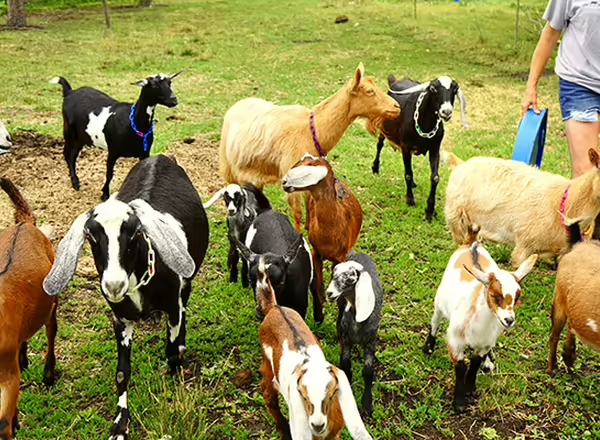
From 2015 to 2018, as their children grew older, the Hoffmans were able to increase their farm production thanks to the help of their kids. Abigail took charge of the goat herd, Brianna managed the poultry, Kayla helped with raising the baby calves, and Johnathon contributed wherever he was needed. They all took to their tasks well enough and learned by doing.
Scott and Anna shared that in the last few years, Brianna and Abigail bought a house together just down the road from the farm, and Kayla has moved in with them. The parents are happy that their kids are becoming independent while also staying close to home.
“Johnathon still lives with us at home and helps chop wood, make hay, and feeds the extra milk to the pigs – which makes the best-tasting pork, by the way!”, added Scott. “As the kids have grown up and left, we’ve had to cut back. We have had to prioritize. We both love dairying, so we are looking to do more of that.”
In the last few years, Anna and Scott have immersed themselves in the world of raw milk from both their cows and their goats. Having drank it themselves for years, they have long wanted to share their passion for raw milk with other families. There is a rigorous permitting process in the state of Illinois, and now having gone through the permitting process, they are licensed to sell raw milk, direct-to-consumer, on their farm.
Some readers may be surprised to learn that selling raw milk is permitted in Illinois. However, more than a dozen Illinois farmers have successfully pursued this small but dedicated niche market. Regardless of public opinion on the safety or perceived health benefits of raw milk, there are buyers all across the state who want to purchase this hard-to-find farm product.
Restrictions on Illinois raw milk sales
First, the milk must be clearly labeled as “raw” and kept separate from other pasteurized dairy products. Second, the farm business must display an advisory informing customers about potential risks, especially to infants, pregnant women, children, immunocompromised individuals, and other high-risk groups. Additionally, the farm is required to send monthly samples for testing to check for bacteria and somatic cell count levels. Finally, the sale of raw milk to consumers can only be done on the farm, directly to the consumer.
I wondered why Scott and Anna would want to offer raw milk for sale when there were so many more regulations they had to deal with, compared to pasteurized milk. It turns out that people come from over an hour away for Hoffman's raw milk - and not just one or two! “We’ll have a dozen or so families per week come for just that - we have a good amount of regular customers,” said Anna. At $10 a gallon, raw milk sales direct-to-consumer on their farm has been a consistent source of revenue for their business.
Anna added, “we’ll be able to offer our raw cow’s milk year-round, but goat milk will be seasonal – April to September.”

Before reaching out to Anna for the interview, I explored the farm’s social media pages and discovered that Hoffman’s Little Acres sells goat milk soaps. It’s beneficial for a farmer to offer various products from the same farm enterprise. Having goats that provide fresh, raw milk as well as value-added products like goat milk soap is the perfect example!
I asked, “How did you come across the idea for making goat milk soap, and how has it been received in the community?”
“Way back when, I took a class on how to make goat milk soap, so before we got our goat herd, I had some idea of what I was going to do. With the first extra goat milk I had, I made my first cruddy-looking soap bars. But they were mine, made with love, with our goat’s milk from our land!” said Anna.
She shared with me that, at first, not even her kids used it. “Every soap we had ever used prior to that time was some type of liquid soap that we bought at the store. It was a new experience for everyone. It took some getting used to but eventually everyone did end up liking it.”
“What’s so special about goat milk soap?” I inquired.
“Almost everyone I’ve talked to that has bought soap and cared to talk to me about their experience has told me that for the first time, their skin feels hydrated after bathing. Many soaps used for body and face wash these days have additives and chemicals in them that can irritate, dehydrate, and more. I’ve never had a bad comment about my goat milk soap, when talking about skin hydration or skin health,” Anna shared.
Besides selling it through Hoffman’s Little Acres farm store, readers can find Anna’s goat milk soap stocked at family businesses in McLean, Livingston, and Woodford county!
After hearing about their soap venture and their on-farm store, where they sell body care products, eggs, meat by the piece, and raw milk, everything started coming together for me. Their business is diverse, resilient to stress and shock, and it’s as hyper-local as possible. How much shorter of a supply chain could there be than out in your barn?
“You really don’t need more than some “Little Acres” to be a small-scale, profitable, resilient, small farm, do you?” I asked Scott. “Nope, you sure don’t! And it provides all the work you could do, and then some!” said Scott.
Emulating the “Little Acres” approach
One more example of how the Little Acres approach can benefit others is the use of the Mini-Jersey breed for milk, instead of the typical Jerseys or larger breeds of milk cow. In recent years, Anna has embraced the mini-Jersey breed. “Besides being completely adorable, they poop less, there’s less feed cost per day to keep them fed, and they still produce a decent amount of milk per cow. They’re the perfect family milk cow and aren’t nearly as big a commitment if you’re just starting out. And if you want more milk, but you want to enjoy the benefits of the minis, just get two. Or more!”
In the small farming world, it is crucial for the longevity of the farm business and for managing stress levels among farmers to keep experimenting with what works and what doesn’t. “When you know something is right for your business, it just clicks. It’s that way for us with the Mini-Jerseys,” said Anna.
The small-farming and rural homesteading lifestyle has gained popularity in recent years. One of the biggest challenges for those interested in pursuing a lifestyle similar to that of Anna and Scott is accessing farmland.
Anyone looking to move to Central Illinois with the goal of purchasing a small farm or unimproved farmland may face various obstacles. Often, land that might have been available for sale changes hands well before it’s ever listed on the public market. Even when it is listed, the per-acre cost of land in the central part of the state is extremely high—often reaching or exceeding $15,000 per acre.
The competition among corn and soybean farmers in the area when additional farmland is up for sale is intense. This competition becomes even tougher if any available acreage includes a livable house. To add insult to injury, these homes are often older and require significant repairs after purchase, if any outsider purchase is ever made.
Getting small-farm experience without a purchase commitment
For those who feel like this farmland access issue is an insurmountable problem, Anna offered some excellent advice.
“You do NOT need to buy or rent a farm to see if this is what you want to do with your life. Instead, if you know where you might want to live and farm one day, start knocking on doors, introducing yourself to that community, sending some emails, making calls, and so on. Look for work with a farmer or farm business in that area, for as long as it takes.”
She continued, “if you can get a job helping somebody trying to farm and live in that community, you’ll build community connections with neighbors. After building trust with them or working for or with them, they might be able to give you an inside track on a property coming up for purchase down the line. News like that travels through the grapevine quickly in a small town”.
“But be prepared to work long and hard hours,” Scott warned. “Nothing about this life is easy. It is rewarding, but there WILL be learning curves, speedbumps, obstacles. It’s hard. No if’s, and’s, or but’s. But we love it.”
Many people may think a particular community or area in a specific state is where they want to live and farm. They go there to apprentice at a vegetable farm, only to discover that it wasn’t what they had imagined, leading them to return home. Fortunately, they can gain valuable experience without having to buy or rent a farm, start a business, or move their family, thereby saving both time and money.
This is the path I pursued. I worked on a vegetable farm in Oregon all of 2020, for an $800/month stipend, plus room and board, and all the answers to all the farm questions I could ever ask. That experience saved me tens of thousands of dollars, plus months or years of time, and was one of the most impactful periods of my life. I realized I did not want to farm full-time, but that I wanted to work to help make the lives of farmers easier - so I joined Illinois Extension.
Illinois Farmlink
There is also one additional up-and-coming, impactful tool which readers interested in farmland access may be interested to learn about. Illinois Farmlink is a powerful land access tool that connects farmland and/or farm business owners, and experienced farmers with would-be farm laborers, potential farm buyers, and others.
As one farmer friend I know said, “effectively it’s a dating service that matches aging, knowledgeable farmers with people who want to learn how to be organic farmers - managing livestock herds, growing organic grains, fruits, vegetables, and more. All you need to do is make a profile, and it’s free to use.”
After more digging on their website, would-be farmers create listings describing their backgrounds and the type of farming skills they’re hoping to learn. Farm or farmland owners list their farm properties, including acreage, tools and implements available, financial situations they’d be open to (leasing, purchase, rent-to-own, etc.), and farm practices they’d be open to seeing on their land. The Land Connection ties it all together by providing Farmland Access Navigators to help readers navigate the process - one only needs to fill out the Advising Request Form on their site.
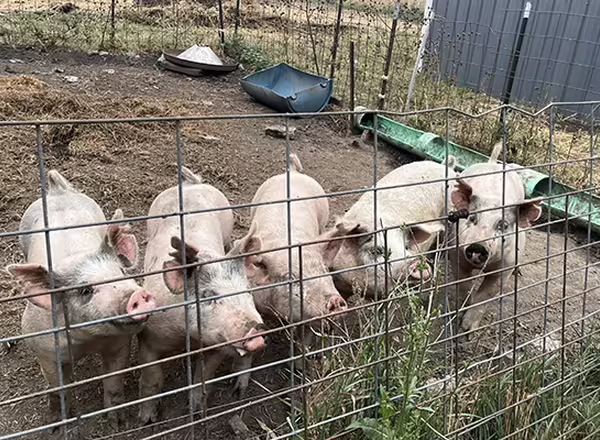
The homesteading and small farm business lifestyle is currently more popular than ever. It’s important to acknowledge that it’s not always easy. In the spirit of transparency, I asked Scott and Anna what they thought was the most difficult aspect of their small farm life.
“Not being able to leave the farm as much, go on vacation, or see family is first in my book,” said Scott. “I haven’t seen my mom in over a year – that’s hard.”
Anna added, “We have a farm helper that works for us every other Saturday, and we have another friend who can take care of our goats. We have a third person that can come take care of the cats if we need to leave or want to, but that’s a huge amount to coordinate, so we only take off about one week a year, in the summer. It’s great to get away when we can.”
I mentioned that a lot of homesteading Instagram influencers make farming look easy and fun, but that it can be extremely difficult, not just physically but mentally.
A few weeks after this interview, Anna shared with me that after 10 years of calving on their farm, they just lost their first calf this past month – the one I had met – which has been “really difficult.”
On a lighter note, I asked, “What’s the most rewarding aspect of your farm life?”
“I love the baby animals every year – cows, goats, doesn’t matter, new life every year is so invigorating,” Anna shared. Scott jumped in. “Helping other people out. Period. Giving them good products, knowing that we are giving them the best food we can create, and knowing that a lot of people depend on us now in our little area. That’s most impactful to me”.
“What advice would you provide to people – older and younger, urban, suburban, rural – that are trying to live their lives in a more self-sufficient manner, but without starting a farm? What would you tell people that would like to learn homesteading skills but haven’t gotten started yet?” I asked both.
“Plan on working hard. None of this is easy at all. It humbles you every day. But providing for yourself and your family is some of the most fulfilling work you can do. Start doing something as soon as you can!” – Anna
“Growing vegetables or raising a couple chickens in a suburban backyard would be a great place to start. Grow some herbs in pot planters if you live in the city and don’t have a yard. If you have a yard, plant some asparagus in a flower bed. Start small and build from that.” – Scott
Illinois Extension Cottage Food Law adds resiliency pathway to small farm business
Before ending the interview, I asked Anna and Scott how Illinois Extension could help their farm business continue to succeed in reaching their goals. “We are taxpayer-funded to troubleshoot problems on-farm, in farm businesses, and small communities. Our job is to help you in achieving your objectives,” I explained.
Anna told me that she would like to begin selling kitchen-made products at farmers’ markets and holiday markets in the coming year and asked how to get started with that. I was able to pass on information to her from our Nutrition and Wellness team about the Illinois Cottage Food Law. Thanks to that law, farmers, home bakers and others can now sell recipe-tested products cooked in home kitchens – not commercial kitchens, provided they have the appropriate training, and labeling.
On my drive home, my brain was overflowing with ideas about how I might be able to make my 0.25 Little Acres around my home more productive and resilient.
WRITER: Nick Frillman Local Food Systems & Small Farms Educator, University of Illinois Extension
ABOUT EXTENSION: Illinois Extension leads public outreach for University of Illinois by translating research into action plans that allow Illinois families, businesses, and community leaders to solve problems, make informed decisions, and adapt to changes and opportunities.
###
University of Illinois | U.S. Department of Agriculture | Local Extension Councils Cooperating
University of Illinois Extension provides equal opportunities in programs and employment.
If you need a reasonable accommodation to participate in this program, please contact us.
Early requests are strongly encouraged to allow sufficient time to meet your access needs.